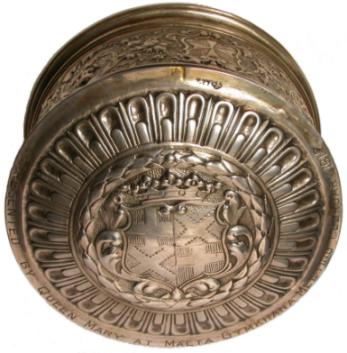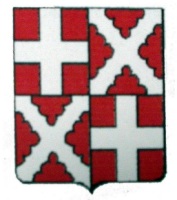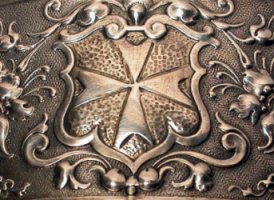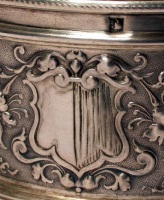click on images to enlarge
The Grand Master's Box
A gilded silver box with an embossed Coat of Arms was a gift to the
Prussian nobleman, Fra' Ferdinand von Hompesch zu Bolheim, titular
Bailiff of Brandenburg, upon his election in 1797 as the 71st Grand
Master of the Knights of St John.
(click note 1)

Having joined the Order, as a page during the reign of Grand Master
Pinto (1741-1773), von Hompesch rose through the ranks, under Grand
Master de Rohan (1775-1797). He, as the Grand Master became a Prince
of the Holy Roman Empire with the ecclesiastical precedence of a
Cardinal and expected to serve the Order for life according to the
Hierosolymitan Order.
(click note 2)
|
This Order of Knights dates from the 11th century and based in Malta
since 1530 had Commanderies across Europe and the eight Auberges on
Malta. Fra' Ferdinand von Hompesch elevation from Chief of the
Anglo-Bavarian language to the Order's highest office was during
turbulent years in Europe.
The French Republic had sequestered the 254 French Commanderies,
depriving the Order of a large part of its revenue, causing a severe
rupture in relations between the two countries. As well, the French
overran the Papal States and Pope Pius VI (1717-1799) exiled to a
monastery near Florence.
In the Mediterranean the French fleet, bypassed Admiral Nelson's fleet
stationed off Sicily and launched attacks on Malta and Gozo on 9th June
1798. The Grand Master's force that consisted of 332 knights supported
by 16,600 militiamen faced the French armada of nearly 400 ships with
more than 50,000 land troops, sailors, marines so within days 250
knights capitulated.
The decision to capitulate was not unanimous, as the Grand Master did
not sign the document. The support he expected from the Order's allies
did not eventuate as Spain refused to come to Malta's aid being an ally
of France and Ferdinand IV had departed Naples for Sicily when the
French occupied southern Italy so was in no position to fulfil his
obligation as military protector.
The French gave the knights the options to defect with a lifetime
pension or depart Malta. Ferdinand IV granted the dispossessed knights
refuge and the Order set up administrative offices on Sicily in 1802
until 1834 when it moved to Rome where the Grand Magistry is an
extra-territorial sovereignty within Italy.
The Grand Master and twenty followers left for Trieste with the Orders
most sacred relics, thus ending the Order's reign in Malta. The relics
being the arm of St John and the Icon of Our Lady of Philermos stripped
of the bejewelled settings.(click
note 3)
Napoleon took the ring that had been on the Hand of the Baptist as his
own and the jewelled sword given by King Philip 11 of Spain (1527-1598)
to the French born, Jean Parisot de la Valette, Grand Master 1557-1568.(click
note 4)
As much of the silver and gold that could be found was confiscated by
the French, few of the silver coins issued during the brief reign of von
Hompesch survive but rarer are the obsidional ingot of 30 Tari value
issued to the occupying French troops.
|
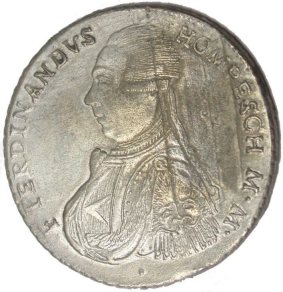
|
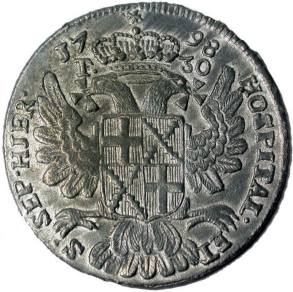
|
The majority of the citizenry of Malta did not accept the French
domination, an insurrection and a two-year siege ending with the
capitulation of the occupying French force of 1,000 to the blockading
British navy on 5th September 1800.
The 1802 Treaty of Amiens recognised the Order's sovereign right to
Malta but the British occupied the archipelago and refused to permit the
Order to return or repossess.
Malta became an important strategic British Dependency with legitimacy
confirmed by the 1814 Treaty of Paris and then the Congress of Vienna,
thus began the British presence on Malta until Independence in 1964.
The Order's income had suffered another blow when Empress Catherine II,
(1729-1796) confiscated the Order's wealthy priory in the Russian
controlled Galacian Volhynian principality of the Ukraine. The Grand
Master had dispatched Bailiff Guiliode Litta–Visconti-Arese to Russia in
1797 with the insignia of the 49th Grand Master La Valette, the hero of
Malta's Great Siege of 1565. The intention being that Czar Paul I
(1754-1801) should assume the role of Protector of the Order and create
a Russian Grand Priory to compensate for the loss of the estates.
With the Grand Master in exile, members of the Russian Grand Priory and
other knights residing in Russia deposed von Hompesch. The Czar,
invested at a ceremony officiated over by Monsignor Lorenzo de Litta,
the Apolostolic Delegate to St Petersburg, assumed the title of the 72nd
Grand Master and not long after invested Field Marshall Graf Suvorov
into his order of knights.
|
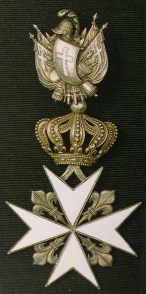
|
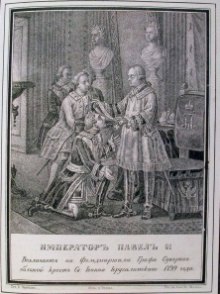
|
This coup d'etat made the Czar de facto ruler of the Order but not Grand
Master de jure as he was neither a Catholic nor celibate and the Holy
See considered the proclamation illegal and void but was powerless to
intervene.
Then the Florentine born, Emperor of the Holy Roman Empire Francis II
(1768-1835) ordered his subject, von Hompesch, to relinquish the office
of Grand Master and send the Order's relics to Austria's Russian ally
and the new Grand Master.
In Russia a group of conspirators, lead by the Governor of St
Petersburg, Count Pahlen proposed to force the mentally unstable Czar to
abdicate in favour of his son but this ended in regicide.
Paul's heir, Czar Alexander (1777-1825), returned the Grand Magistracy
to Rome but retained the position as Grand Prior of Russia. Pope Pius
VII (1740-1823) then designated Bailiff Giovanni Battista Tommasi as the
73rd Grand Master of the Order in 1803, a post he held for two years.
He outlived by a month von Hompesch who died in penury on the 12th May
1805, at Montpellier, France, aged 61 years.(click
note 5)
An interregnum existed from 1805 to 1879 when Papal appointed
lieutenants ruled the Order. On 28th March 1879 the lieutenant of the
Knights Hospitaller of St John of Jerusalem since 1872, the Austrian
nobleman Johann Baptist Geschi di Santa Croce was elevated by Pope Leo
XIII 'motu proprio' to be the 74th Grand Master.
Later in the century, George Frederick Ernest Albert of the House of
Saxe-Cobourg-Gotha married his cousin, Victoria Mary Augusta Louise Olga
Pauline Claudine Agnes, the daughter of the Duke of Teck of the House of
Wurtemberg on 6th July 1893.
On 22nd June 1911, he was crowned George V, King of the United Kingdom
of Great Britain and Ireland and of the British Dominions beyond the
Seas, Defender of the Faith and Emperor of India. He also became the
Sovereign Head and Patron of The Grand Priory of the Order of The
Hospital of St John of Jerusalem in England and the Queen a Lady of
Justice of the same Order.
To attend their Coronation Durbar in India the new P & O ship Medina,
was fitted out as a Royal Yacht. On 10th January 1912, the King and
Queen left India on the return voyage with a stop at Malta.
(click note 6)
The Royal couple were greeted by the Governor and C.I.C. of Malta,
(1909-1915), Gen. Sir Henry Macleod Leslie Rundle G.C.B., K.C.B.,
K.C.M.G., C.M.G., D.S.O. who was a Knight of Grace of the Order of the
Hospital of St John of Jerusalem in England and is wife Lady Eleanor
Georgina a Lady of Grace of the same Order.
(click note 7)
During a busy three days stay they attended numerous events and on 25th
January, there was an athletic carnival at the Marsa Sports Club.
A circular box, later engraved on the rim, was “Presented by Queen Mary
at Malta Gymkhana Meeting February 1912.”
The lid of the silver and gilded box has the embossed Coat of Arms of
Ferdinand von Hompesch and on the side is the Cross and Shield of Malta.
A silversmith whose mark (?A?) is uncertain made the box in the Papal
State of Foligno as indicated by a fleur de lis used late 1700's into
early 1800's.
In its travels, the box passed through Naples and acquired on the lid
and base the State mark of Partenope head with 'E' and '8' (used between
1823 and 1870's for '883 1/3' foreign silver
click note 8)) and somewhere else (Germany?) as indicated by
'800'.
|
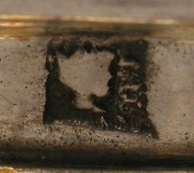
|
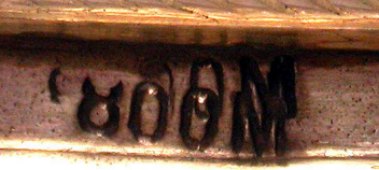
|
The box, 60mmx115mm and weighing 280g, probably for tobacco, has 'M'
stamped twice on the base, in differing scrip, probably indicating being
assayed in Trieste and Malta.
How this box with such an extraordinary past survived is surprising but
poses many unanswered questions. Where was it during the 19th century,
how did it return to Malta and who was the recipient in 1912 are a few
of those questions?
(click note 9)
References:
Knights of Malta & Montpellier. Britannica CD. Version 97. Encyclopaedia
Britannica, Inc., 1997.
Michael Baigent, Richard Leigh & Henry Lincoln. The Messianic Legacy.
Corgi Book, U.K., 1986.
Insight Guide. Malta. Editor Geoffrey A. Ross, APA Publication (HK) Ltd,
1996.
John Bowle. Napoleon. Weidenfeld & Nicolson, London, 1973.
Burkes Peerage, Baronetage & Knightage. London 1912.
V. A. Durov. Russian and Soviet Military Awards” Order of Lenin State
History Museum. 1990.
The Sunday Times, Christmas Supplement, 10th December 1989.
Virginia Cowles. The Romanovs. Penguin Books, Harmondworth, U.K. 1974.
E.J. King. The Knights of St John in the British Empire. John Wright &
Sons Ltd., Stonebridge House, Bristol. 1934.
Internet sites:
Order of Malta
- Official site
pomocmaltanska.tripod.com/history
perso.libertysurf.fr/heraldique_europeene/Malte_GM
A Short History of the Order of St. John of Jerusalem
napoleon.org/us/us_cd/bib/articles/textes/malta1798
The blessed Virgin Mary venerated in the Order of Malta
Maltese Obsidional Coins - Siege Silver Ingot of 30 Tari
copyright by F. A. Sinfield ©
|

